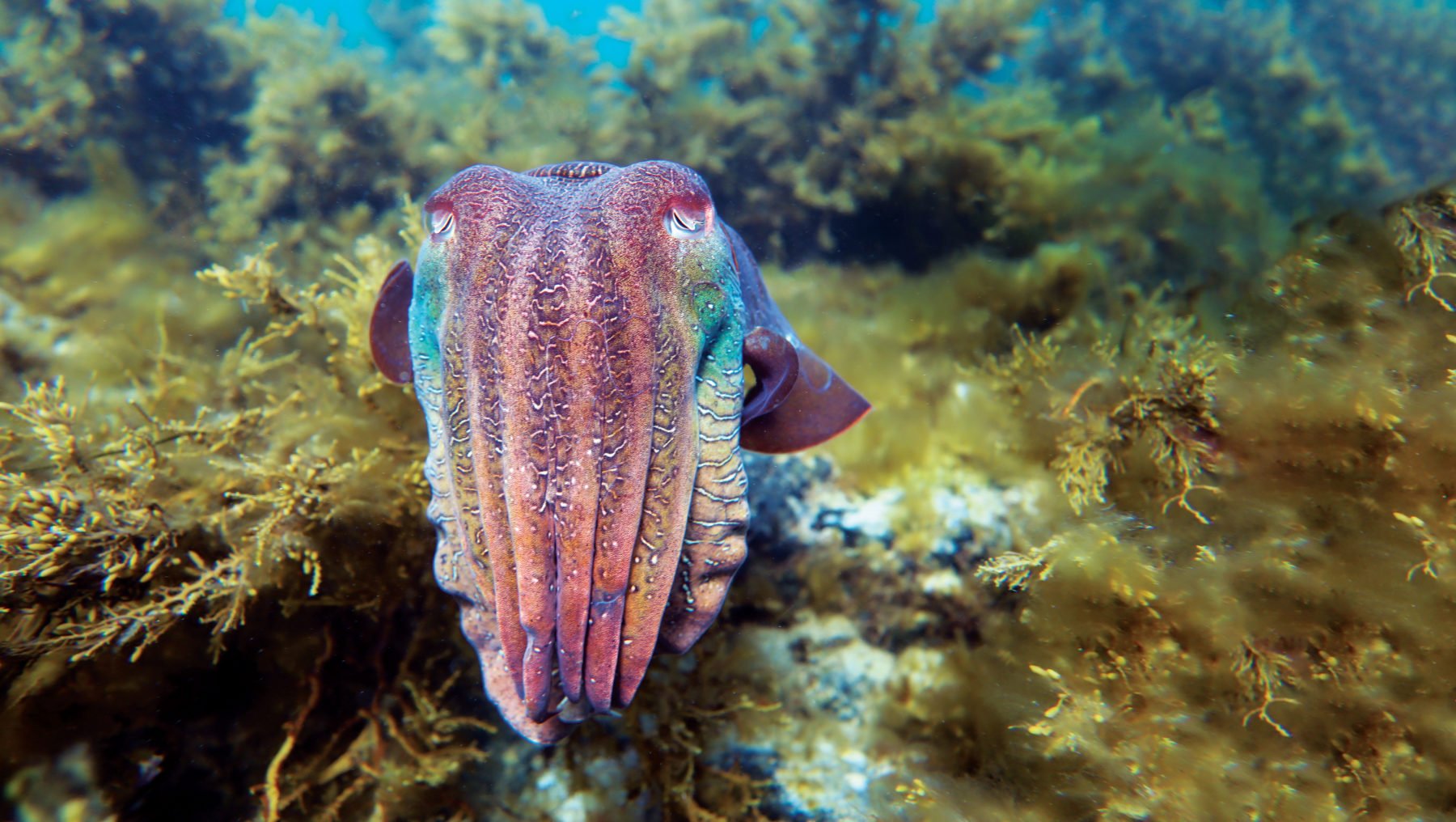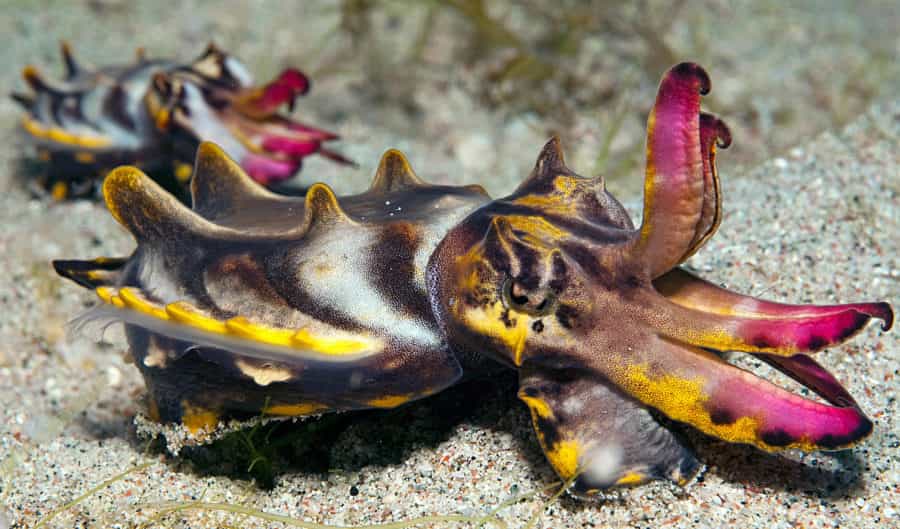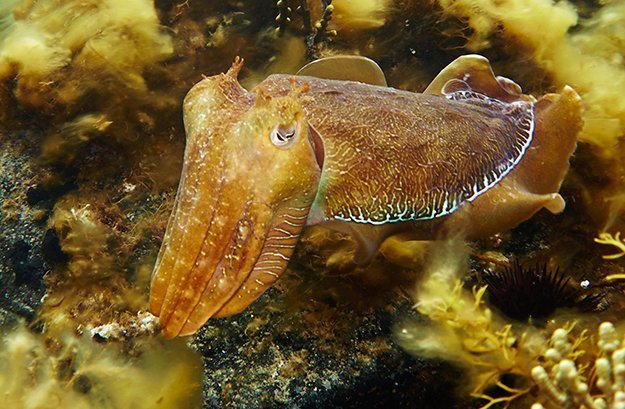Each year along the Eyre Peninsula’s Spencer Gulf in South Australia, visitors usually arrive from around the globe to see one of the marine world’s greatest natural spectacles. Just a 38km drive from the industrial and shipping town of Whyalla, in a stretch of water surrounding Point Lowly and Stony Point that includes False Bay, an annual migration of the Australian giant cuttlefish takes place. It’s the only known migration of its kind – unique not just to Australia, but to the world.
Cuttlefish belong to the animal group known as cephalopods. They are usually solitary animals that hide camouflaged in seaweed, under rocks and in underwater crevices. But adult giant cuttlefish abandon isolation each May to August and arrive in the tens of thousands, impelled by the need to mate and lay eggs.
So incredible is this event that legendary naturalist Sir David Attenborough included footage of it in his famous Blue Planet series. And, before COVID-19, media from around the world would arrive each year at the same time as the cuttlefish to film, photograph and report on this now world famous natural phenomenon.
With more and more people becoming aware of the migration, Whyalla locals recognised its tourism potential and in 2018 launched Cuttlefest – an annual festival spanning June to August. Despite COVID-19 limitations on international travel this year, the festival is expected to be a huge drawcard for domestic tourists, offering a line-up of dedicated events to provide education about the species and involve visitors in this unique migration.
I visited during last year’s season, and a quick visit to the Whyalla Visitor Centre equipped me with a list of the many activities that were on offer.
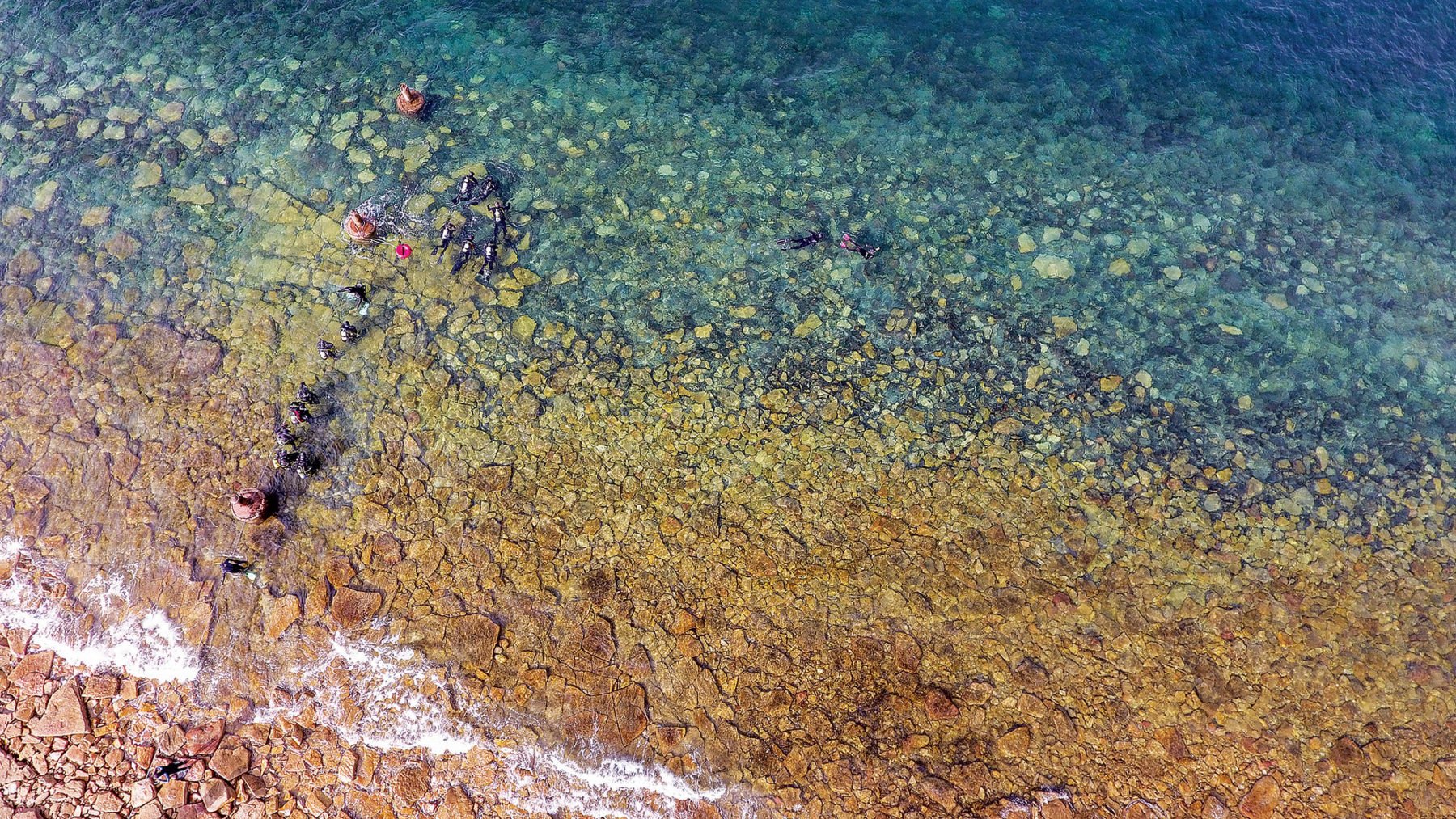
Top of my list was the opportunity to snorkel or dive with the giant cuttlefish. This can be done on a community snorkel led by an experienced guide, or on your own with a snorkel buddy. If you aren’t comfortable getting in the water, there’s an opportunity to experience it with a pair of 3D virtual reality (VR) goggles or by scanning a QR code for a virtual tour on your smartphone.
For the younger ones, a school holiday program is on offer; favourite activities include making cuttle-rocks and playing hide-and-seek around town like these chameleons of the sea.
Popular also is the Cuttlefish Art Competition that welcomes entries created across all kinds of media, with artists often making sculptures from recycled materials picked up from the beach.
I started my tour of town with a self-guided drive of the Cuttlefish Art Trail that directed me to fabulous murals, sculptures and works of art decorating the foreshore and streets. Not to be missed is the main street at night, which displays cuttlefish lanterns creating a sea of colour.
Down on the recently opened jetty, I rested a moment on a huge mosaic cuttlefish seat and basked in the sense of pride the Whyalla community has for its cuttlefish visitors.
Soon it was time for me to see the phenomenon for myself. With ocean temperatures at about 10°C, kitting up for a snorkel takes some effort. I climbed into a base layer suit, then added an extra vest with hood – 7mm of wetsuit, booties and gloves.
With just a tiny bit of skin left showing around my face, all that would feel the cold now were my lips. Jonas Rehrmann, a divemaster from Germany, was my guide, and provided a wealth of information on what I was observing.
“It is easy to get carried away out there with so many cuttlefish,” Jonas said. “I urge you to slow down and spend some time with just one group because then you will experience their habits and behaviours.
“In the smaller animals it is almost impossible to distinguish males from females, but the older males will be huge. They are show-offs and will stretch their bodies sideways, presenting a display of changing, beautiful colours, trying to look big and beautiful, to get the attention of the female and mate. While these bull males are busy showing off, smaller males move in pretending to be female, to stealthily snatch their girl away,” Jonas continued.
“Stay still and watch a group of cuttlefish and you will witness all of this being played out before your eyes. On average there are 10 times more male cuttlefish than females and there can be up to 10 males around one female, trying to mate. Females are polyandrous, meaning they have more than one male mate at one time, ensuring better genetic variability of the species.”
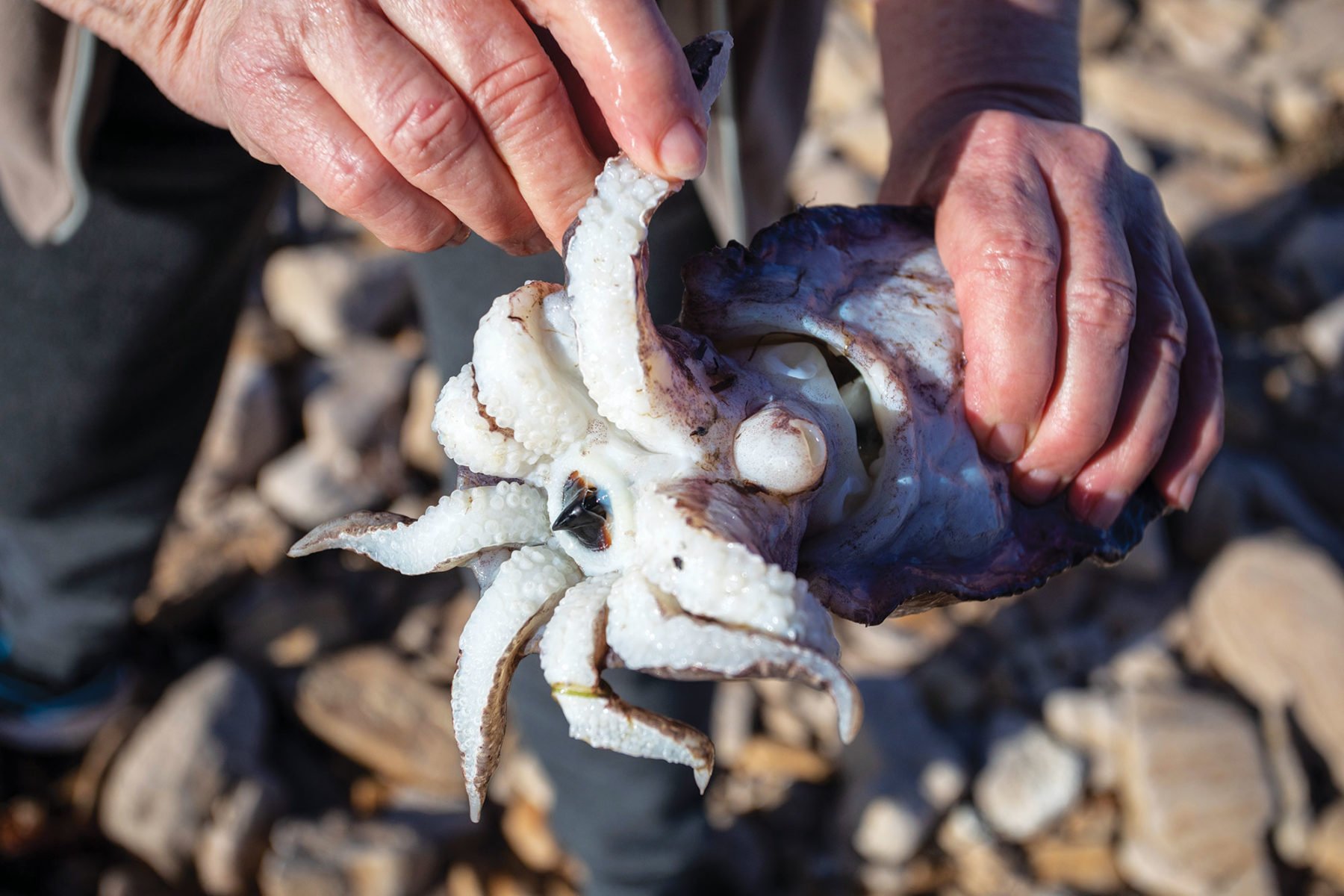
The water was choppy so I edged my way carefully over the rocky shoreline, just metres from land, and was immediately swimming above a majestic example of a giant cuttlefish. The species is the world’s largest cuttlefish – they can reach up to a metre in overall length and 10kg in weight. This individual was a pulsating galaxy of colour, changing from purple to blue, green, white and yellow.
A bull male glided up to me and seemed very relaxed in my presence. His eight silk-like arms were outstretched and he was flashing what looked like little LED lights all over his body. I later learnt this is called strobing. With every dive I see and learn more of this animal’s fascinating behaviours. Incredibly, not only do the body colours change, but also the texture of the skin, from smooth to rocky and spiky.
I witnessed many couples mating head to head, which takes up to seven minutes, the male inserting sperm into an opening near the female’s mouth. A few hours later, the female lays her eggs on the underside of a rock ledge while the male tries to hide her from sight.
The species is semelparous, meaning the female has only one single reproductive episode, and then she dies. So the species’ lifespan is brief – less than two years.
The scene was mesmerising and after more than an hour in the water my face felt frozen solid, but I remained transfixed. Out of the water I chatted to others about their experience. “I didn’t even know cuttlefish were a thing,” said Grace Coy from Adelaide. “But everyone I talked to was like, you must go and see the cuttlefish. I’m so glad I came.” Alesha McSweeney from Perth said, “Wow! I never get tired of these guys. They are so weird, so mysterious. And they’re one of the only marine creatures I know that really aren’t bothered by us. They don’t mind us being there, sharing their space, whatsoever. It’s spectacular…so many of them in one place.”

Cuttlefish numbers here haven’t always been so prolific. In 2013 they crashed to 13,000 from 180,000, instigating a commercial fishing ban on the breeding ground and surrounding areas. Last year, with the count back up to about 200,000, the ban was lifted in zones through which the cuttlefish must pass to reach their breeding areas, rendering the species susceptible to exploitation once more.
“This species is extremely vulnerable and fragile,” said Tony Bramley, owner of Whyalla Diving Services, expressing his concerns about the species’ future. “We have an obligation to the world to preserve this phenomenon. As the only known migration of its kind in the world, the eyes of the globe are upon us.”
For now, a delicate balance plays out either side of the area’s heritage-listed Point Lowly lighthouse – the iconic landmark that serves as a marker between the fishing and the no-fishing zones for cuttlefish. To one side, tourists travel from around the world to enter the chilly waters and witness the astounding cuttlefish aggregation. They see these animals mating and displaying intriguing performances of courtship and camouflage. On the other side, where the fishing ban has been lifted, boats gather and fishers crowd the shoreline, harvesting individuals from this same population of cuttlefish.
At the time of printing this issue of Australian Geographic, David Basham, SA’s minister for primary industries and regional development, was planning to uphold the 2020 decision to relax the fishing bans during this year’s cuttlefish migration season, saying, “The latest SARDI (South Australian Research and Development Institute) survey, which showed record numbers of cuttlefish in the Spencer Gulf, suggested fishing outside of False Bay had a ‘negligible’ impact on cuttlefish stocks.”
This peaceful little township on the Eyre Peninsula has a strong industrial background of mining, engineering and steel manufacturing, but it confidently burst through to become known worldwide as a hub for nature-based experiences and events. So it’s not surprising there are now behind-the-scenes battles to protect the giant cuttlefish.
“Whyalla is an explosion of activity when the giant cuttlefish come to town,” said Teresa Coles, visitor experience coordinator for the Whyalla Visitor Centre. “The entire town feels alive and re-energised.”
